Breguet Classique Grande Complication 5317 Reviewed by Tim Mosso
by Tim Mosso
Imagine a modern-day rookie baseball player named “Babe Ruth.” He could make a few all-star teams, win gold gloves, take home a World Series ring, and have a conventionally great career.
And none of it would matter, because he’s named after a larger-than-life figure — the most famous and accomplished star ever to play the game. The kid would be dogged by a ghost, carry the burden of a dead man’s name, and he’d never find success on his own terms. Because in baseball, there’s only one “Babe Ruth.” And in watchmaking, there’s only one “Breguet.”
Abraham-Louis Breguet died in 1823 after a career that pushed the boundaries of mathematics, engineering, science, and horology. François-Paul Journe once described Breguet to me as a watchmaker by chance and a genius by birth; Journe believed Breguet would be designing rocket ships and A.I. if he were alive today.
Breguet’s innumerable innovations included, among others, overcoil hairsprings, automatic winding, double-direct impulse escapements, shock protection, and, of course, the tourbillon regulator.
Today’s Breguet watch brand lives in the long shadow of its founder. No other luxury watch maison feels the same impulse to market itself as though long-dead founders were still living people; no other manufacturer bears such a constant burden of proof.
Watch collectors have made their peace with the fact that Jaeger, LeCoultre, Patek, Philippe, A. Lange and his Söhne long ago departed these mortal coils.
But with Breguet, it’s different.
Or is it? Replace the famous marquee with the name of a hip independent or one of the Swiss “holy trinity,” and a tourbillon watch like the Breguet Classique Grande Complication 5317 would cause a sensation.

Breguet Classique Grande Complication 5317
On its own terms as a modern luxury article, the 5317 is both a wonder and a comparative value.
The value part is easy; these retail for around $145,200 and sell used — in platinum! — for around 60 grand. The wonder, well, that reveals itself by degrees.
Despite its relative obscurity, the 5317 is a longstanding stalwart of Breguet’s high end collections, launching at Baselworld in 2005. Although bowing amid a decade that celebrated monster case dimensions and two, three, or even four tourbillon regulators per watch, the 39mm 5317 sports only one example of Breguet’s signature invention.
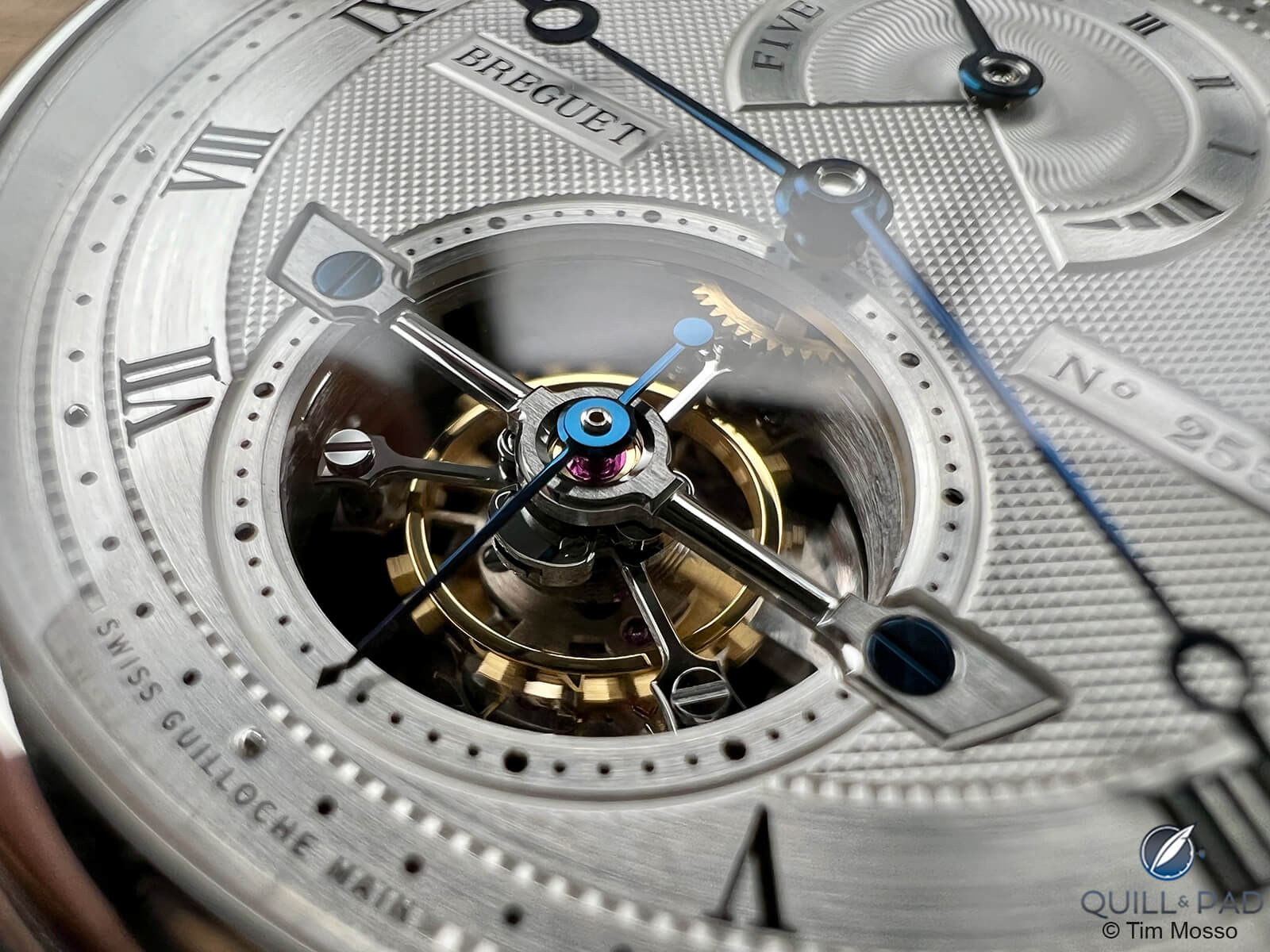
Breguet Classique Grande Complication 5317
That said, this is a tourbillon done right. The bridge is brushed and micro-beveled at its edges, retained by cobalt blue fired steel screws, and fully rounded with specular finish bracketing the upper pivot. Dial-side execution on a modern tourbillon watch needs to be flawless, and this example is.
The rounded sink engulfing the upper tourbillon carriage pivot jewel is dished and mirrored with perfect symmetry. The tri-spoke tourbillon cage doubles as a second hand and exhibits the same virtuosity as the bridge, albeit on smaller components.
The free sprung regulator and overcoil hairspring — Breguet, of course — speak to its maker’s equal interest in timekeeping precision. As with most upper-shelf Breguet models, the 5317 includes a dial blank cut from a solid disc of 18-karat gold.
At least, that’s how the dial starts. Additional decoration calls attention to another overlooked virtue of Breguet-the-brand: guillochage. A collection of vintage straight-line and rose engines populate the Breguet factory in Le Sentier. They and their skilled operators are responsible for the guilloché patterns that define this manufacture’s house style.
Before elaborating, it’s worth emphasizing how many brands of all sizes do not make dials. Independents including H. Moser & Cie., Czapek, and Laurent Ferrier are open about not being able to craft these components without passing meaningful excess expenses to customers, and brands as large as Audemars Piguet and Vacheron Constantin continued to purchase dials at least into the last decade.
Breguet’s guilloché is more than just a stylistic homage to the work of its patriarch; cutting and styling solid gold dials is a commanding accomplishment.
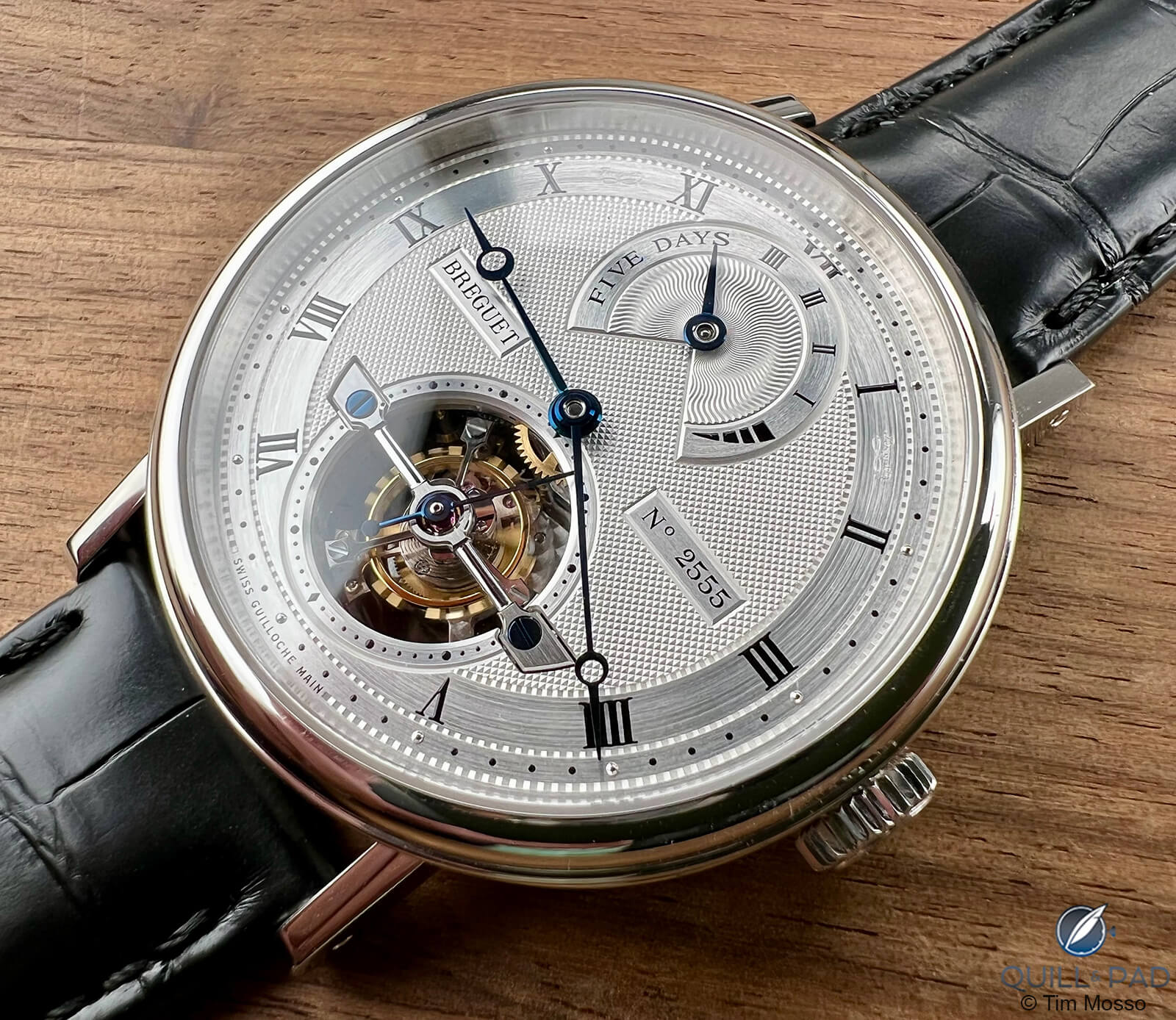
Breguet Classique Grande Complication 5317
As for the dial details, they’re splendid but conservative. Texturing in the form of clous de Paris dominates the center dial and yields only to the satin finish engulfing the hour track, power reserve indicator, and tourbillon. A spectacular soleil cut fronts the power reserve display, and the outer dial incorporates several serrated “dental” tracks.
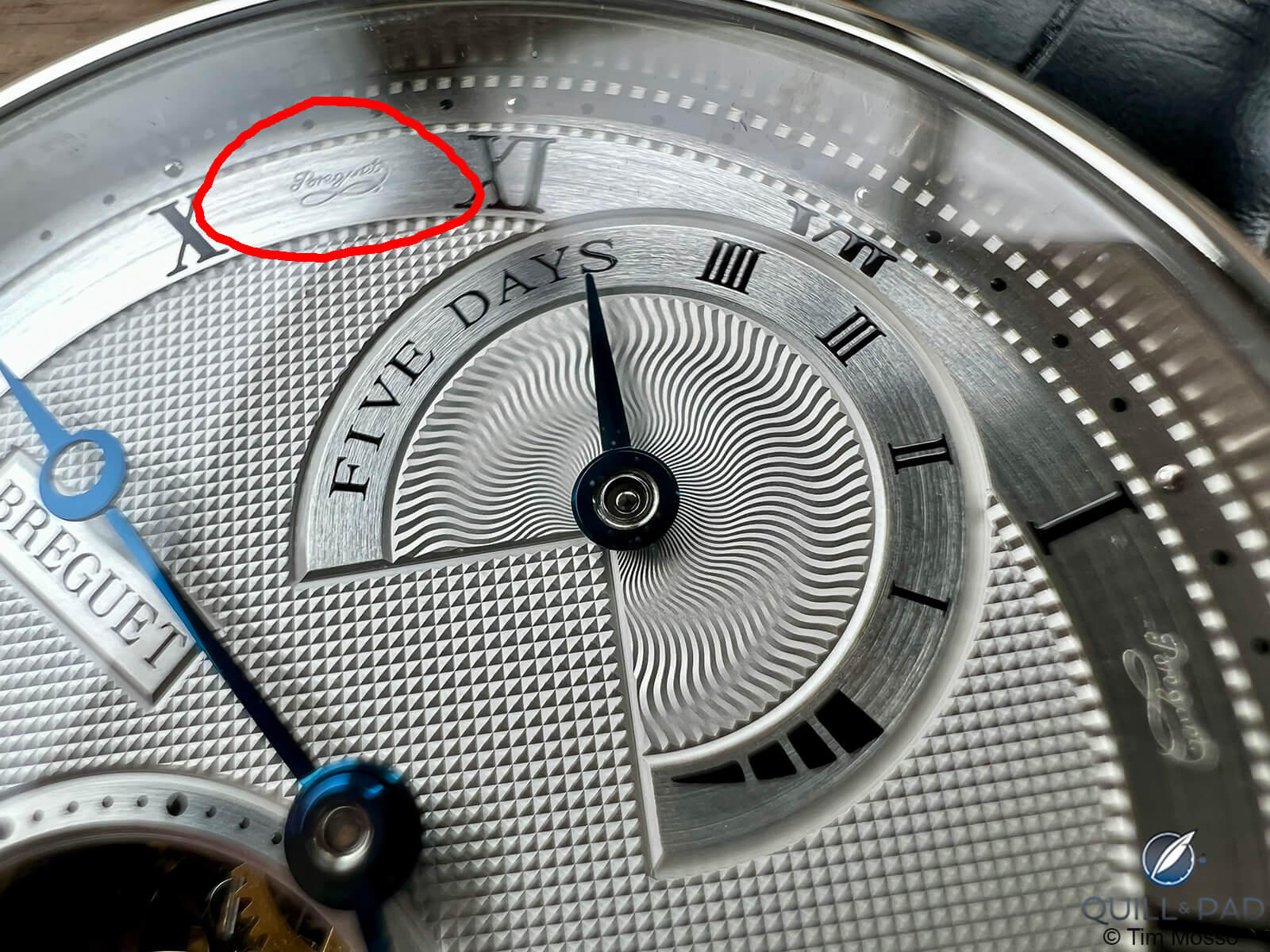
Secret signature on the Breguet Classique Grande Complication 5317
Subtle white gold cabochon hours punctuate the hour track, and all hands are fired blue steel. The pantograph-cut “Breguet” micro scripts on the upper flank of the hour track are known as a “secret signature,” but like its printed counterpart at Cartier, this “secret” is a history play more likely to elude aging eyes than counterfeiters.
To be sure, there are nits to pick. The only egregious element is the “FIVE DAYS” advert on the power reserve scale. Even if you were to buy this used for $60,000, chances are that you would do enough homework to know what you’re getting without the jarring typographical sales pitch.
And even if that text can be considered a surrogate for Roman numeral “V,” it’s distracting enough that the observer might overlook the authentically cool non-linear reserve indicator that accelerates through its travel.
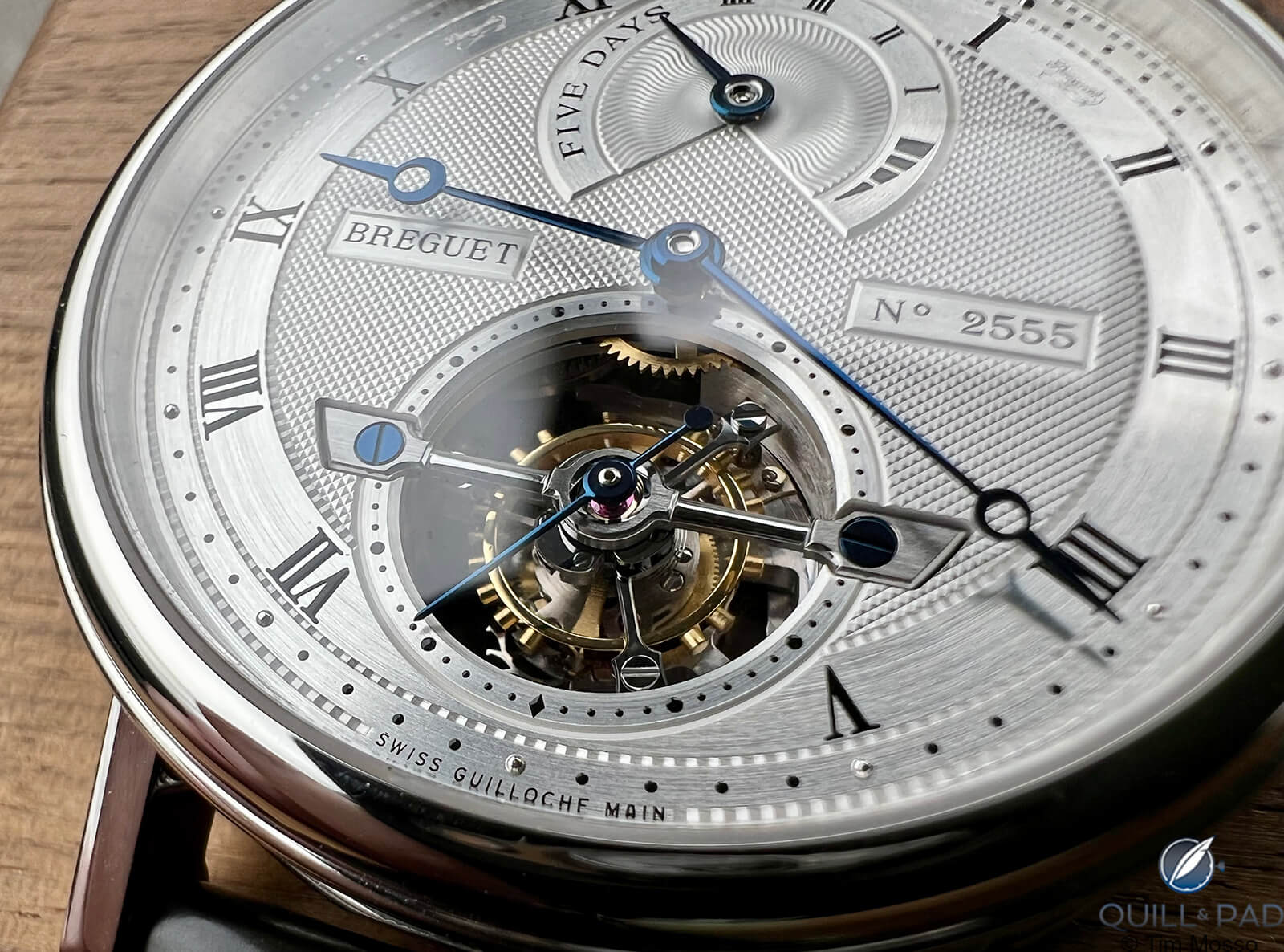
Breguet Classique Grande Complication 5317
Text in general is a weak point on this dial. “FIVE DAYS” is English… but “Guilloche Main” at the base of the dial is French… and the “Swiss” right next to it should read “Suisse” for consistency. Stay tuned, because more Franglish awaits on the caseback.
Stylistically, the 5317 looks fine but frumpy. That’s an honest assessment of Breguet’s modern house style dating back to Breguet’s Daniel Roth era 1980s and additional contributions by Jorg Hysek in the early 1990s.
After years spent attempting to reconcile historic Breguet pocket watch dials with the modern concept of wristwatch cases, Breguet seems to have settled on a case that looks like it might be a genetic missing link between wrist and pocket instruments.
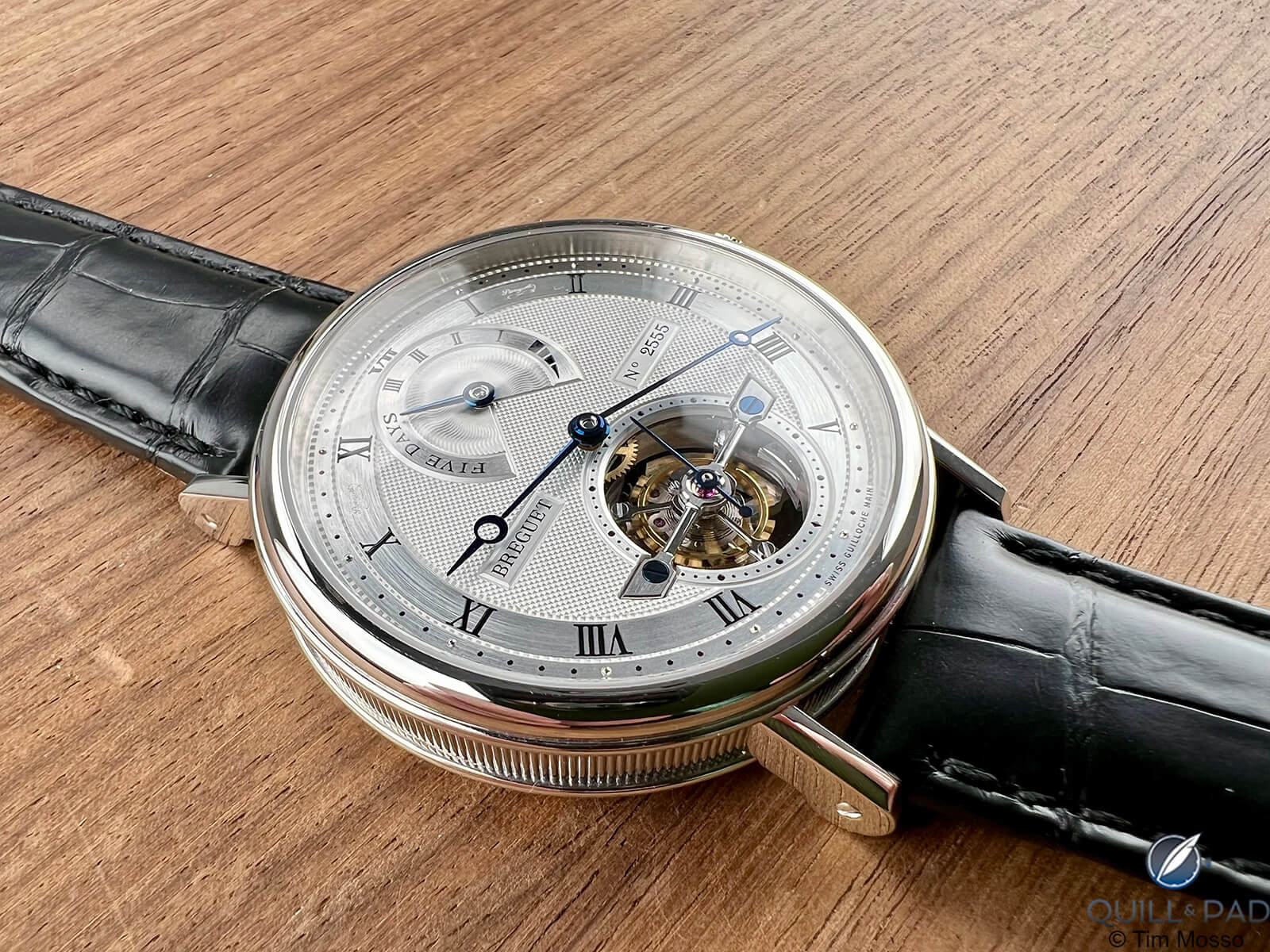
Breguet Classique Grande Complication 5317
Moreover, the look of the arrow-straight lugs is as archaic as the ergonomics are challenging. Due to the particular shape of Breguet’s overhanging lugs, I’ve found that all watches of this style — which is most Breguet wristwatches — wear large for their rated sizes. So, this watch is 39mm, but the fit is 41-42mm in practical terms.
Not all of the case critique is negative, because the money invested is self-evident. Overlapping flanges of bezel and caseback define a belt line embellished by circumferential coining. The coining on top-level Breguet models is cold-rolled and brought to retail appearance by manual refinement.
The welded-on lugs certainly impress with their clean execution, and very little evidence of the underlying weld remains. When combined with the screw-and-bar strap fixtures, it’s clear that Breguet spent real time and effort making this case by laborious means. The tropes may be debatable, but the quality of the execution isn’t.
This “Grande Complication” is something of a misnomer. Traditionally, the term applies to a watch combining a minimum of a perpetual calendar, a minute repeater, and a chronograph. A tourbillon isn’t even part of the definition! The Breguet 5317 is “grand” and “complicated,” but it’s not a “grande complication.”
What it is… is spectacular. The watch’s baroque dial gives way to a rococo caseback dominated by skeletonization, engraving, and all the fine finish flourishes whose French names confound Instagrammers.
While many haute horlogerie devotees swear by manual wind watches, this rotor might compel second thoughts. Engraving — another of modern Breguet’s in-house specialties — is on full display as a massive script “B” with mirror finish dominates the first layer of decoration.
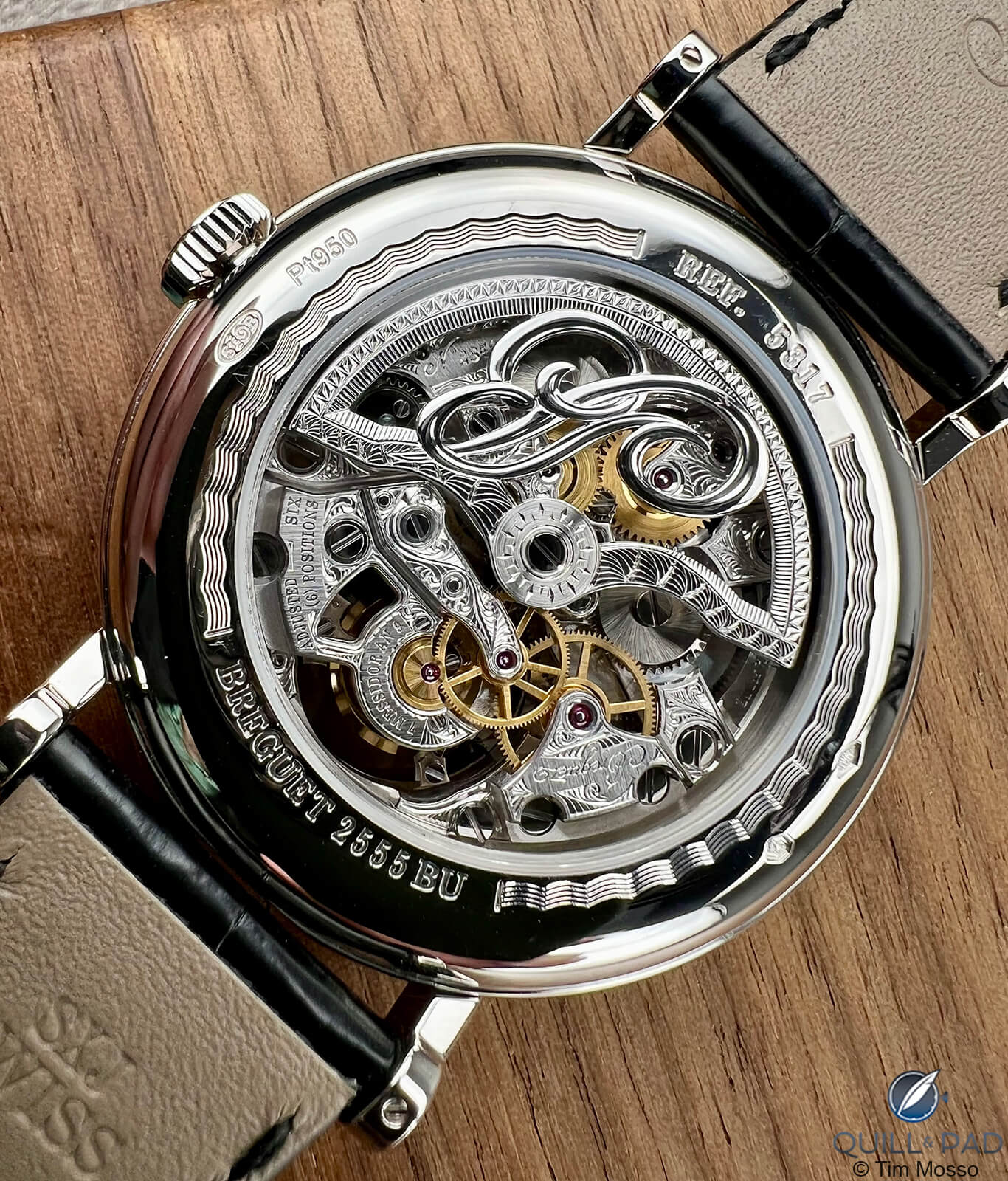
Movement of the Breguet Classique Grande Complication 5317
The rotor is a skeletonized micro-sculptural beauty in its own right, and that’s only the opener. Bridges are engraved with an elaborate variation on fleurisanne patterns and cleanly beveled on their peripheries.
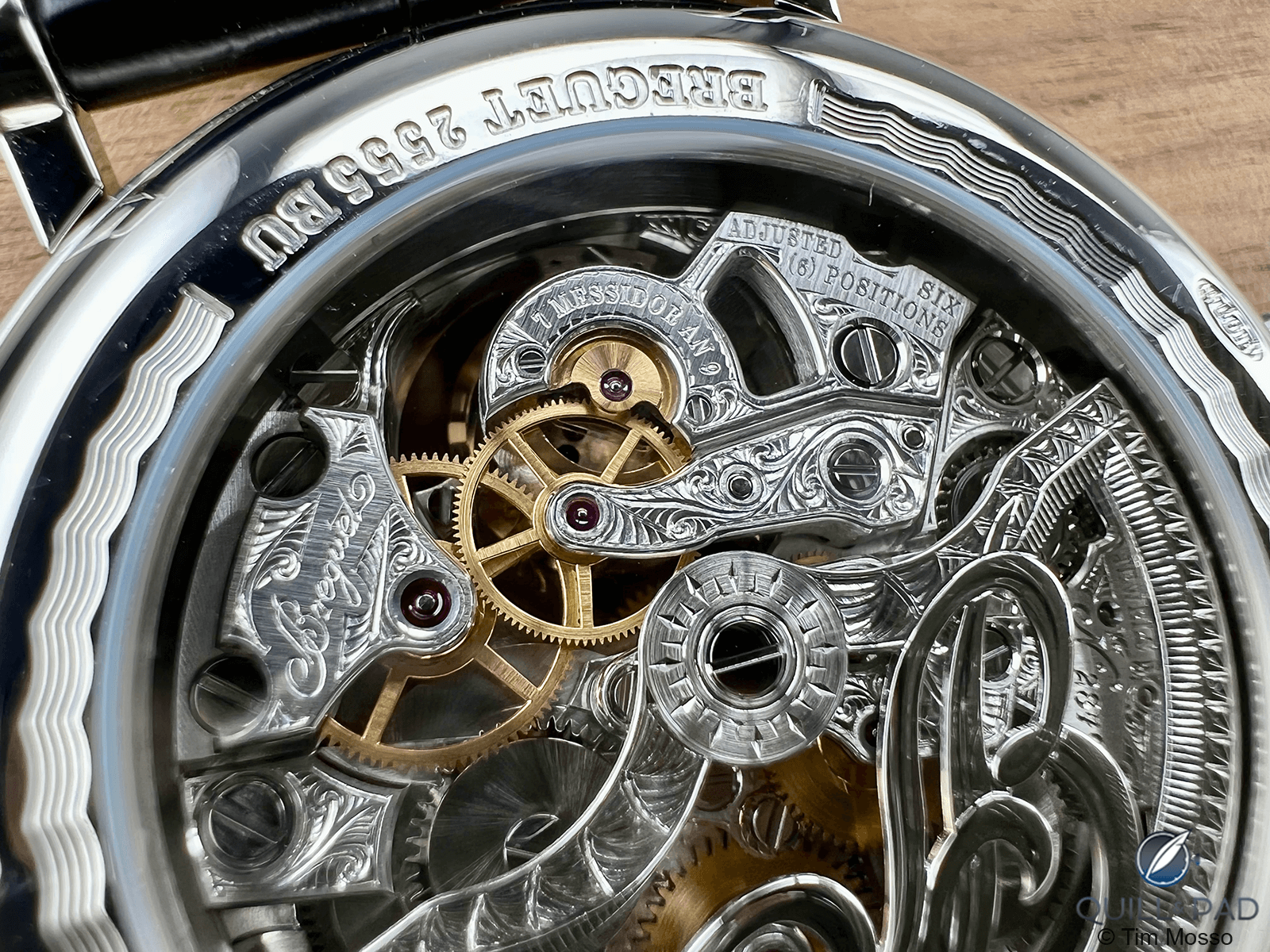
Movement of the Breguet Classique Grande Complication 5317
Screw heads, the crown wheel core, and locating posts used to align bridges with plates feature mirrored “black” polish — so named because it only reflects light when viewed from a certain angle. The ratchet wheel features sharp solarization, and all train wheels are brushed satin.
Even more impressive is the fact that the train wheels include internal bevels often overlooked even at “holy trinity” levels.
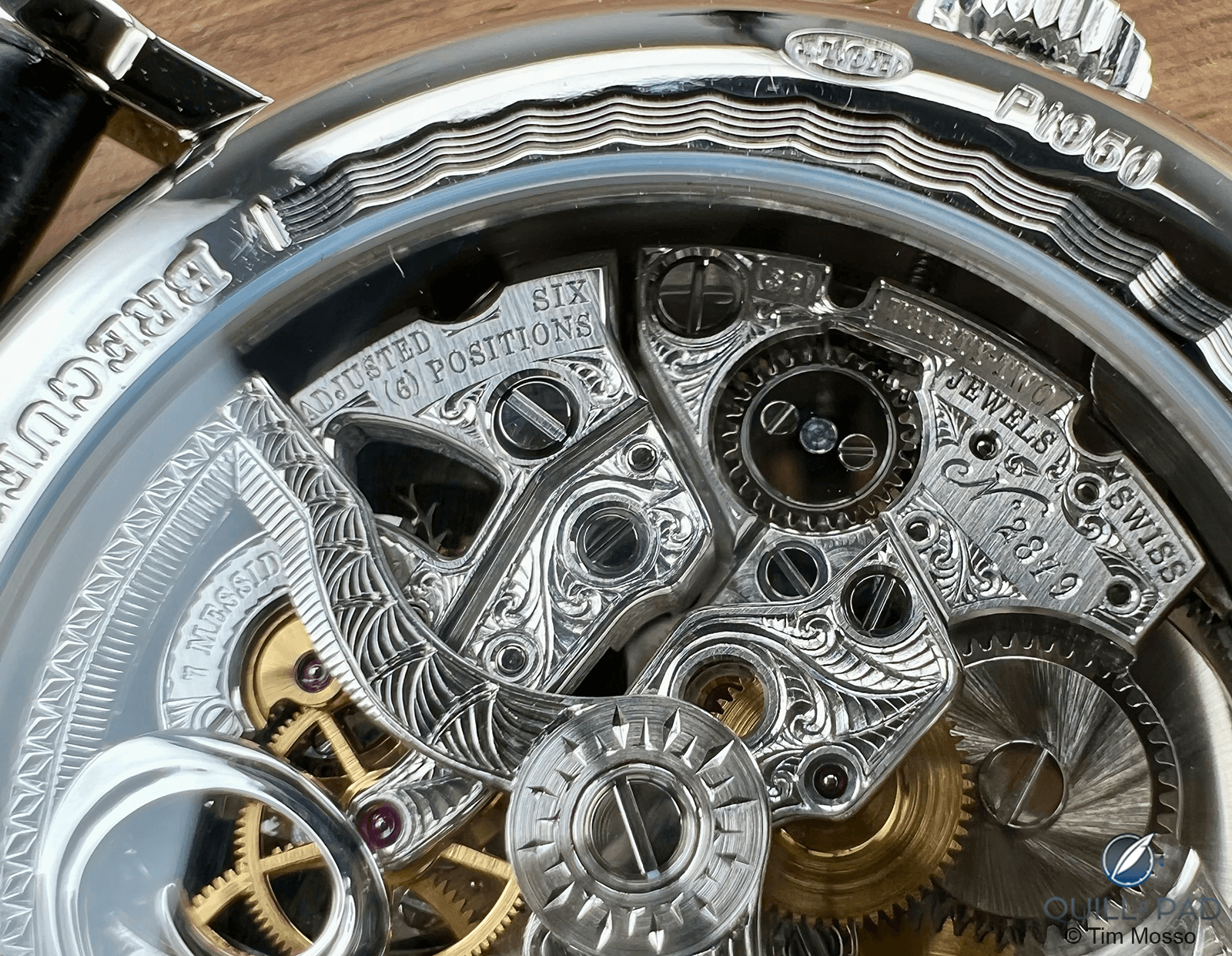
Breguet Classique Grande Complication 5317 adjusted to six positions
Aesthetically, the caseback of the 5317 leaves little to be desired. But perfectionists who linger will wonder why mixed English and French text keeps appearing at random. For example: it’s gratifying to see this premier timepiece is regulated in six positions rather than the standard five positions for a chronometer.
But why does the English adjustment text appear immediately alongside of a French declaration of “7 Messidor An 9?” The Revolutionary-era French Republican calendar refers to June 26, 1801, the day Breguet patented the tourbillon, but its presence on the same bridge as the regulation note is discordant.
Separately, the bevels are clean, but the lack of sharp interior creases where bevels meet must be regarded as a missed opportunity on a movement that otherwise is a standout.
Mechanically, the 5317 impresses. Although Lemania and Breguet have been formally associated for decades, the 1999 purchase of both by Swatch Group led to the inevitable integration of Lemania as “Manufacture Breguet” in 2003.

Movement of the Breguet Classique Grande Complication 5317
The caliber 587 DR combines the unlikely alliance of a 120-hour power reserve, automatic winding, and a tourbillon regulator. A 3Hz beat rate ensures pleasing aesthetics and a stately heartbeat when held against the ear.
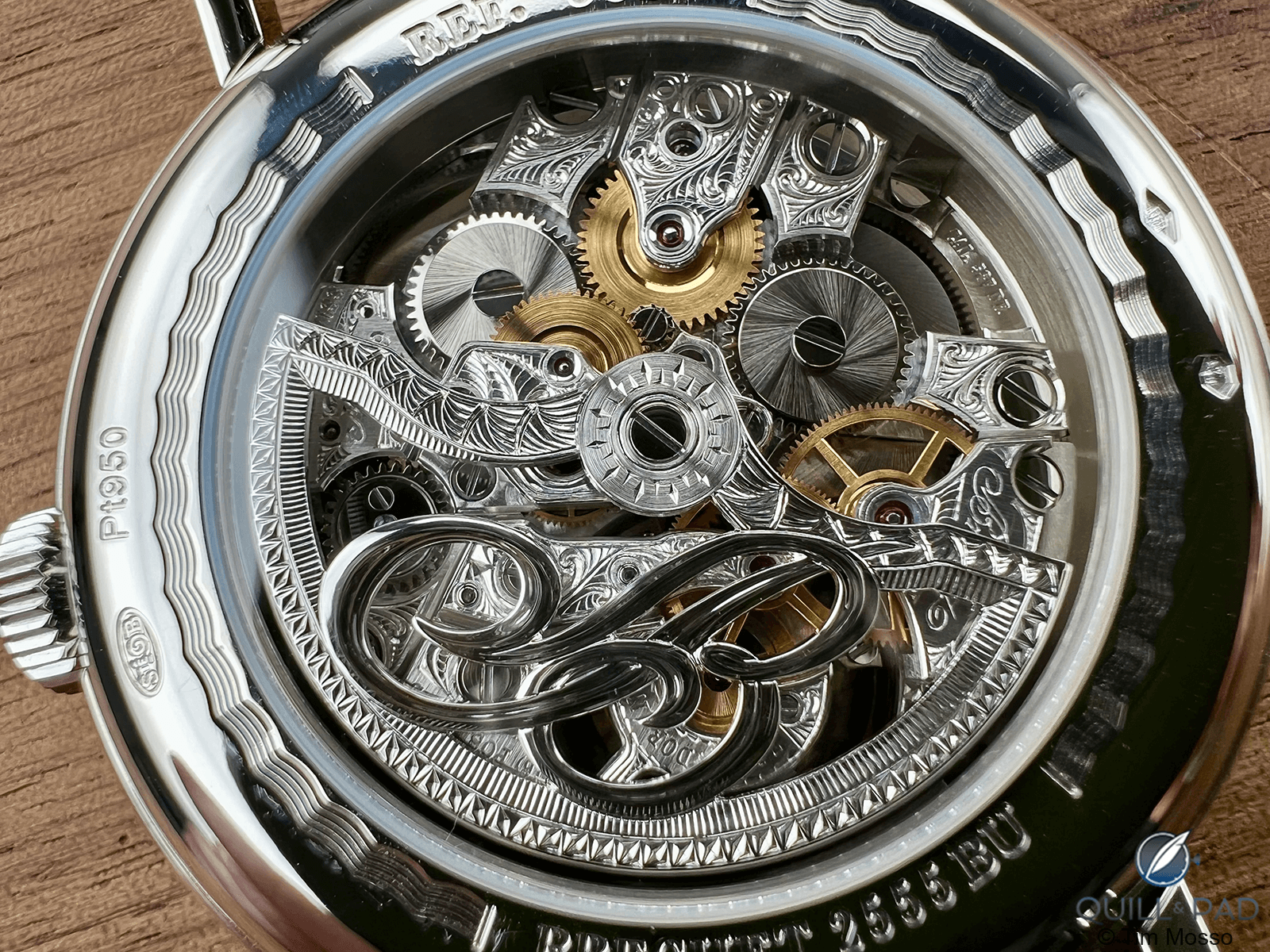
Movement of the Breguet Classique Grande Complication 5317
While not a large movement, the 28mm+ 587DR is suited well to the size of this case. It’s also a thin movement that permits an overall watch thickness of 11.3mm.
“Breguet” is both a charm and a curse to the modern house bearing the most famous name in watches. Exactly 200 years after the founding father’s passing, Breguet — the brand — may need to acknowledge more publicly that Breguet — the man — is finally dead. No, Abraham-Louis did not design the Classique 5317. Yes, it is still a masterpiece.
One of the lessons of the current independent watchmaking boom is that brands with charismatic central figures tend to be the most successful. You can introduce living people, build narratives around them, and make them the faces of inherently emotional enterprises.
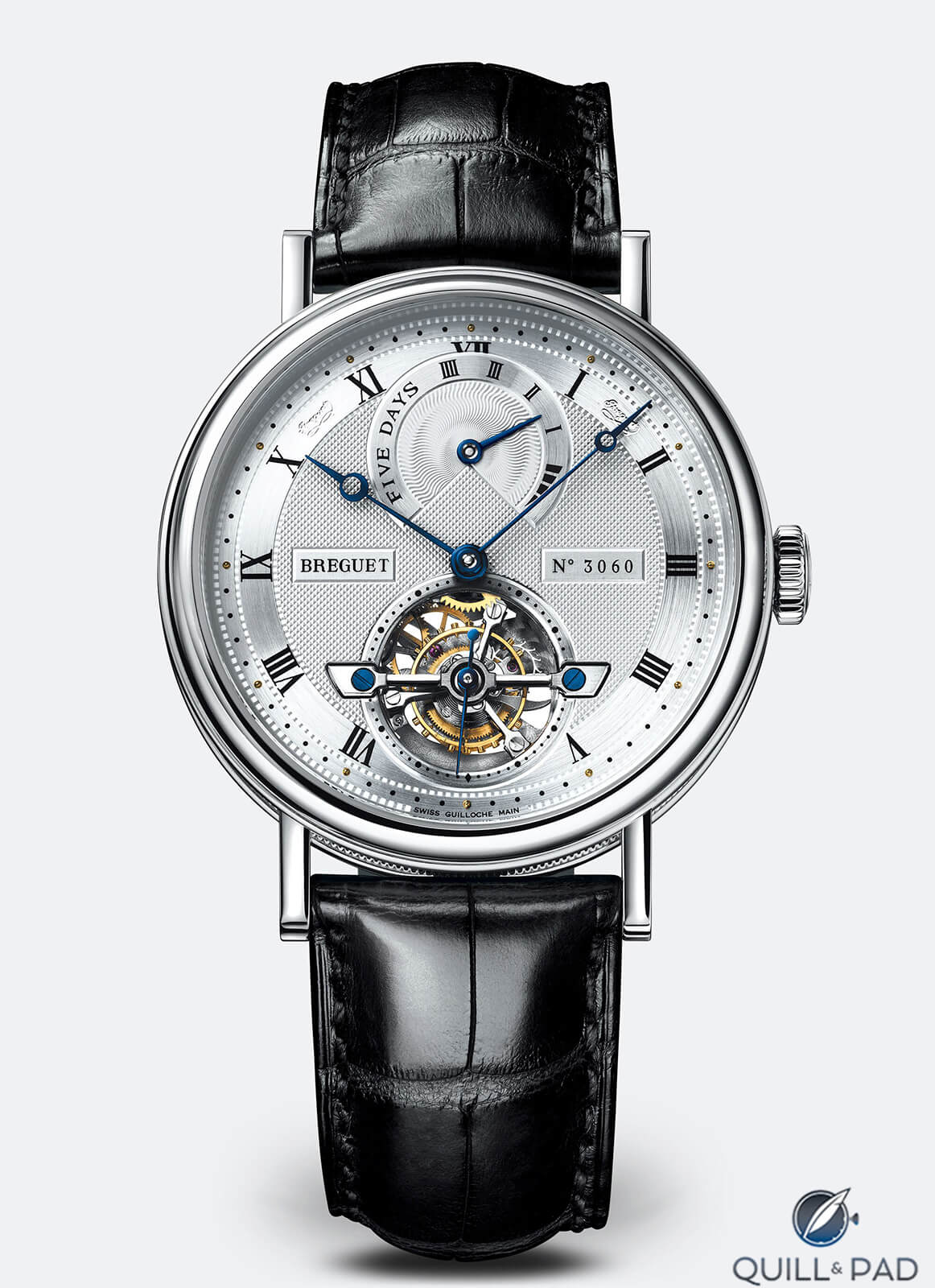
Breguet Classique Grande Complication 5317
If Swatch’s flagship brand ever hopes to step from beneath the shadow of Abe, it should consider advertising and cultivating the images of the living Breguet creators who realize standouts like the 5317.
For more information, please visit www.breguet.com/en/timepieces/classique-complications/5317
* Tim Mosso is the media director and watch specialist at Watchbox. You can check out his very comprehensive YouTube channel at www.youtube.com/@WatchBoxStudios/videos
You might also enjoy:
Is Breguet Ready for a Comeback? And if so, How?
Emmanuel Breguet Talks Fakes In The Time Of Abraham-Louis Breguet And Much More
Breguet And The 2022 Classique Calendrier Reference 7337: It Brings Back Many Memories
The Breguet A2: It Does Up To 40 Kilometers Per Hour And Doesn’t Tell The Time



Leave a Reply
Want to join the discussion?Feel free to contribute!